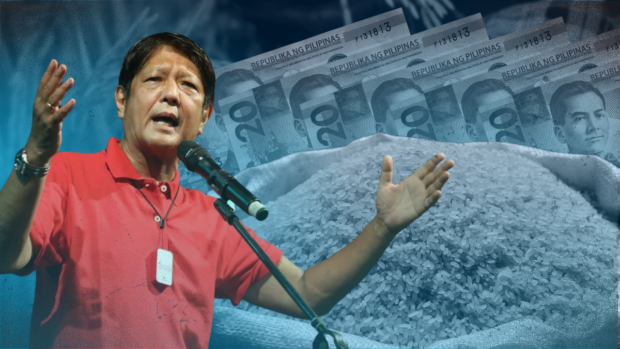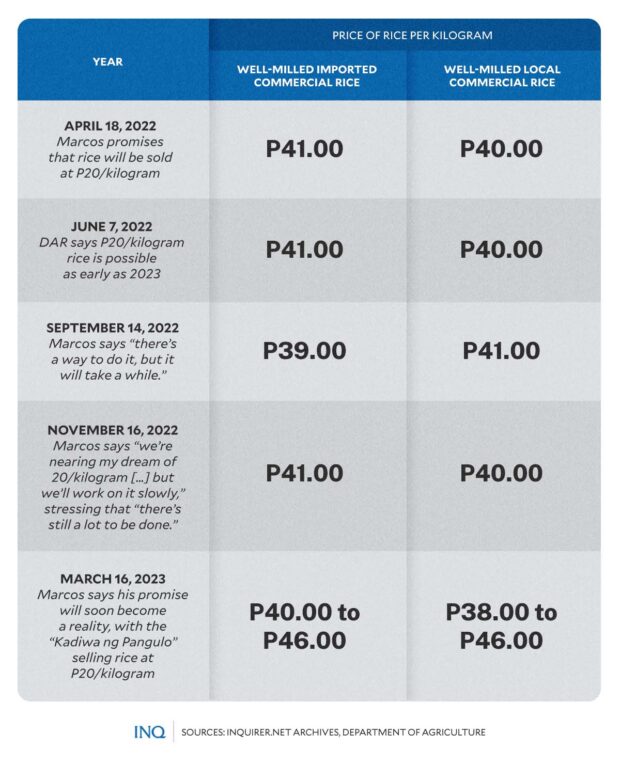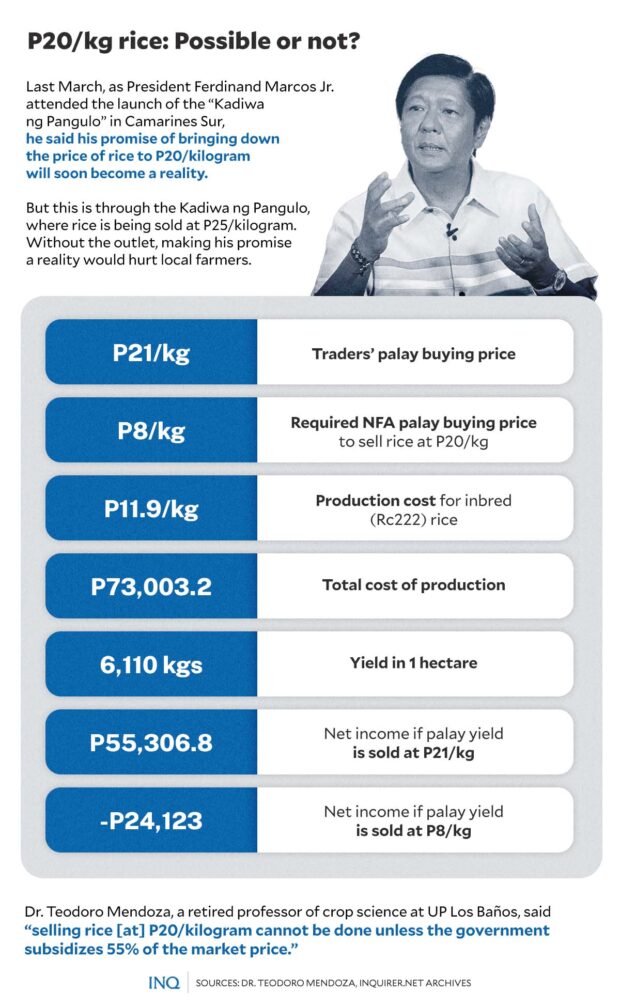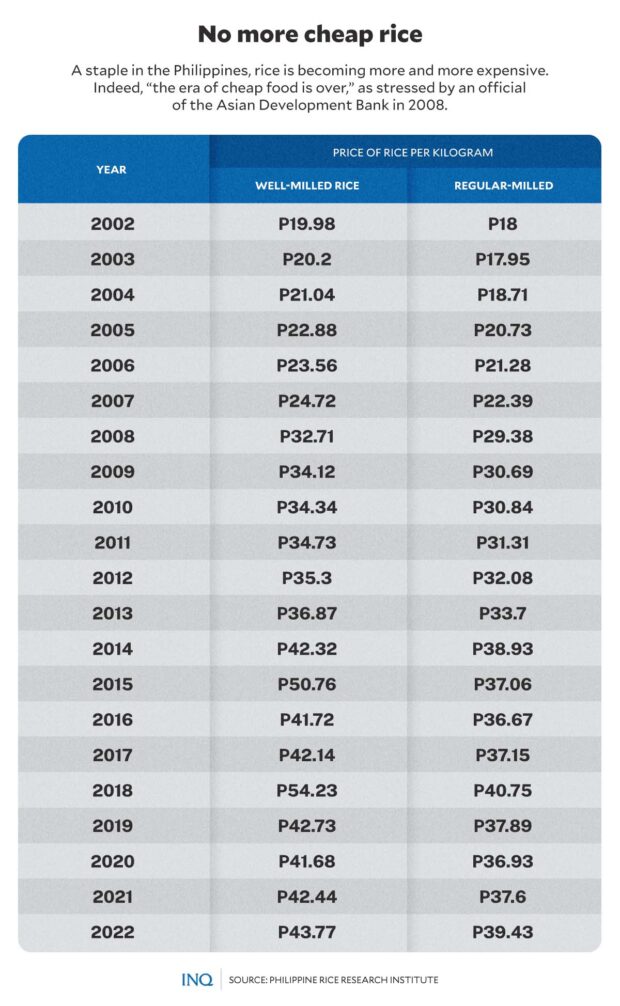A year into Bongbong Marcos’ rule: P20/kg rice becomes a conundrum
MANILA, Philippines—A year ago, a promise was made—the price of rice will be brought down to P20 a kilo. It was a vow criticized as “impossible,” but President Ferdinand Marcos Jr. said he will make it a reality.
READ: Bongbong Marcos vows to bring down price of rice
How? He said he will recommend a price cap and issue an executive order directing the Department of Agriculture (DA) and the National Food Authority (NFA) to buy rice harvests from local farmers at higher prices.
Marcos said there is a need for a consistent and thorough inventory of rice harvests all over the Philippines. Rice cartels should be prevented from controlling the supply, too, he stressed.
READ: The wait-and-see period for Bongbong Marcos’ ‘P20 rice’ promise
Looking back, Marcos, who is also the agriculture secretary, had stressed that bringing down the price of rice to P20 a kilo is possible, but it won’t be easy. “There’s a way to do it but it may take a while,” he said in an interview over ALLTV.
But a year into his presidency, he said the “P20 rice” that he promised will soon become a reality. “We’re getting there,” he said, pointing out that “we are already at P25 a kilo […] we can bring that down soon.”
Article continues after this advertisementREAD: Bongbong Marcos on P20 per kilo rice: Coming soon
Yes, rice is already being sold at P25 a kilo but only in government outlets, like the “Kadiwa ng Pangulo.” Marcos, last year, said “we are getting closer and closer to my dream,” but referred, too, to how rice is being sold at P25 a kilo in government outlets.
Article continues after this advertisementSo now, is it really possible to bring down the price of rice to P20?
Dr. Teodoro Mendoza, a retired professor of crop science at the University of the Philippines Los Baños, told INQUIRER.net that “[it] cannot be done unless the government subsidizes 55 percent of the market price.”
Why? Because the reality is that bringing down the price of rice to P20 will hurt Filipino farmers most. “They will be disadvantaged,” Mendoza said in a phone call on Thursday (June 22).
Left with nothing
Mendoza presented data to show how expensive rice farming is and why it is impossible to sell a kilo of rice at P20 without the government subsidizing 55 percent of the market price.
Take a look at this.
A farmer will plant an inbred variety, like Rc222, on a hectare of land, and as pointed out by Mendoza, the cost of production is P73,003.2, or P11.9 a kilo. A hectare is expected to yield 6,110 kilos.
Mendoza explained that the NFA’s palay buying price for its buffer stock, or the optimal level that shall be maintained and used for relief programs especially when calamities hit, is P19 a kilo.
Now, to be able to sell rice at P20 a kilo as promised by Marcos, he said the NFA has to buy palay from local farmers at only P8 a kilo, which is already impossible as this will leave farmers with nothing but losses.
Mendoza pointed out that with P8 as buying price, the 6,110 kilos of rice harvest per hectare will only translate to income of P48,880, leaving the farmer with a loss worth P24,123—the difference of 73,003.2 and P48,880.
But if palay will be brought at P21 a kilo, the rice harvest of 6,110 kilos will translate to P128,310, giving the farmer a net income of P55,306.8, making it possible for him to till his land again.
“A farmer should have a net income of at least P60,000 for every hectare,” Mendoza said, stressing that once a farmer incurs losses, he or she will not be able to pay his debts, leaving him or her with no option but to lease or sell his or her land.
Private traders, he said, are currently buying palay at P21 to P23 a kilo because of the threat of El Niño. With this, the choice that local farmers will take is already obvious, Mendoza said.
‘Era of cheap food is over’
As early as 2008, an official of the Asian Development Bank already told the Foreign Correspondents’ Association that “we just have to accept [that] the era of cheap food is over.”
Over a decade later, what the official said has become reality, as based on data from the Philippine Rice Research Institute (PhilRice), rice, a staple for millions of families, is becoming more expensive than ever to grow.
PhilRice said a kilo of well-milled and regular-milled rice in 2002 was only P19.98 and P18 in 2002. Some 20 years later, the price of the staple increased to P43.77 for well-milled and P39.43 for regular-milled.
Last April the DA said it was expecting the retail prices of rice to increase by as much as P5 a kilo because of the confluence of factors like the low buffer stock, higher prices of palay, and higher production cost because of expensive farm inputs.
Assistant Agriculture Secretary Rex Estoperez especially pointed out that “if the farm gate price [of palay] goes up, that will translate to higher selling prices [for rice],” which is usually double the farm gate palay price.
READ: Rice prices expected to rise – DA
Last year, Mendoza also stressed that a rice shortage, triggered by low buying price for palay, higher production cost that can result in low rice harvest, could increase the price of the staple.
Based on data from the Philippine Statistics Authority (PSA), which has been shared by the DA to INQUIRER.net, the annual palay production in 2022 reached 19.756 million metric tons, lower by 1.02 percent compared to 2021’s.
However, the Federation of Free Farmers (FFF) pointed out that the PSA announced, too, that the 2022 yearend stock was only 1.76 million metric tons, which is good only for 48 days.
“If this was correct, then production in 2022 should have gone down by 18 percent and not 1 percent,” FFF explained.
Based on data from the DA as of June 22, a kilo of well-milled imported commercial rice is worth P40 to P46, while a kilo of well-milled local commercial rice is worth P38 to P46.
The DA said back in January, a kilo of well-milled imported commercial rice was only worth P40 to P44, while a kilo of well-milled local commercial rice was being sold at only P38 to P44.
‘Be realistic’
Mendoza said the government has to be realistic, saying that the “P20 rice” promise will not be possible for every Filipino, especially now that even if the NFA sticks to its buying price of P19 a kilo, it will still be hard because private traders buy at P23 a kilo.
READ: Higher production costs, low gov’t buying price add to rice crisis specter
What the government should do, he said, is to have a rice lane, where the 10 million food poor households can buy subsidized rice at P20 a kilo. “This is the most practical,” he said.
Based on data from the Social Weather Stations, more Filipino households saw themselves as food poor in the first quarter of this year, rising from 8.7 million in December 2022 to 10.6 million in March 2023.
READ: More Filipino families consider themselves food poor in Q1 of 2023 — SWS
The SWS poll from last March 26 to 29 — its results released on May 7— found that 39 percent of the families considered themselves food poor – an increase from 34 percent to 39 percent.
“The government has to be realistic,” Mendoza said, stressing that it should focus on finding a remedy for market forces.
“There is inflation then you will only buy palay from farmers at a very low price [to sell it at lower prices in the market] will put farmers at the losing end. What will happen to them?” he said.
RELATED STORY: P20 per kilo rice possible as early as 2023 – DAR
TSB



